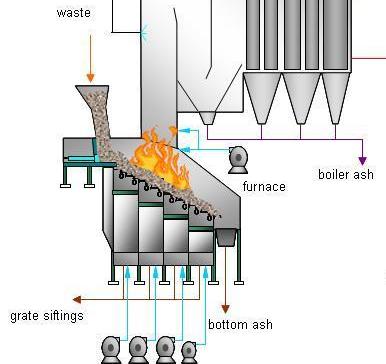Moving Grate
- Photo 1: A domestic waste incinerator for non-recyclable waste.
- Photo 2: The weight bridge
- Photo 3: The waste bunker
- Photo 4: The air extraction fans take air in the waste bunker to feed the incinerator with oxigen (O2).
- Photo 5: The control room
- Photo 6: The fournice, with +/-950 degree C
- Photo 7: The grate incinerator
- Photo 8: The monitor system of the combustion chamber for optimal combustion.
- Photo 9: The ash disposial of the incinerator.
- Photo 10: Ash transport and metal recycling
- Photo 11: Control pannel of the ash bunker gates and hopper
- Photo 12: Ash disposal bunker with hopper for loading the ashes to the truck
- Photo 13: The flue gas dust storage tanks
- Photo 14: Dust evacuation system from the dust filters in closed containers
- Photo 15: The energy recuperation system
- Photo 16: The chimney or stack
Grate incinerator for communal waste
Domestic or communal waste is, afther recycling techniques, still 30% of the total amount rejected by the community. This goes into the grate incinerator and this waste has enough caloric value to burn without support fuel. The starting up of the incinerator is done with support burners untill the fournice has a high temperature: +/-950 degree Celcius.

Photo: a moving grate incinerator
Incineration process
The waste is left by the garbage trucks in the waste bunker of the incineration plant. Afther the garbage is putted by the hopper from the waste bunker in the incinerator. By shifting and tumbling tiles the waste moves slowely down and burns. The combustion chamber is feeded with air from the waste bunker. This stinking air can not excape from the incineration plant and contains also oxigen (O2) for the degasification and the combustion process. The temperature is +/-950 degree Celcius and the retantion time of the waste in the furnace is +/-45 minutes till 1 hour.
Afther the combustion step remains two type of residous:
-
The ash, this is +/-10% of the orginal volume of the waste
-
Flue gasses at high temperature
The ashes are cooled and big pieces are separated. The cooled ash passes by an elektromagnet which separetes the metals from the ashes and the ash is stored in an ash bunker. In this ash bunker a hopper load the ash to a truck and a specialized company recycles the semi-conductors and separate some toxic substances from the ashes. Afther this treatment the ashes contain only non-hasardous substances and the ashes are used as construction materials.
Flue gas treatment system
The flue gas treatment system is the biggest part of a waste to energy plant or domestic waste incinerator. The flue gasses have to be cleaned very carefully before the enter the chimney or stack. The European directives for emissions are important restrictions for exploitating the incinerator plant.
Financial aspects and operation costs numbers of a waste-to-energy plant
The operation costs are depending from country to country. We give some numbers which are "normal practice" in West Europe. Also installations are only profitable if the have more then 100.000 ton waste per year and if they are on full power. So the incinerator has to be always in process, +/- 7000 - 8000 hours/year. We give here some numbers to inform you, but they are rather to give an idea, for specific prices please contact us.
Incomes, profits and benefits
-
Waste deposite fee: +/- 100 - 125 euro/ton
-
Income from energy recuperation: This depends on the caloric value of the waste. But you may count 590 KWh/ton household waste
-
Income from Iron recycling out of the ashes: 0,1 euro/ton waste
There are also other types of income like foundations for production of ecological energy, but this depends from country to country and is not mentioned here.
Costs
- Start up and buy cost: 535 euro/ton per year
- maintenance costs: 1,4 euro/ton per year
Only when the incineration plant is big enought, like more then 100.000 ton/year waste, this are approximate numbers what are the estimated costs and profits or benfits from a domestic waste incineration plant.
MSW incineration related links and download files


